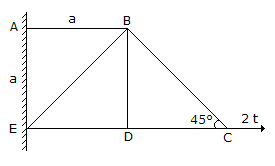Civil Engineering :: Applied Mechanics and Graphic Statics
-
In the structure shown in below figure, the member which carries zero force, is

- If two equal forces of magnitude ‘P’ act at an angle ‘θ’, their resultant, will be
- A projectile is thrown at an angle ‘α’ to the horizontal with velocity ‘v’. It will have the maximum centripetal acceleration
- Varingon’s theorem of moment’s states
- The resultant of two forces acting at right angles is 5 kgf and if they act at an angle of 60°, it is 37 kgf. The magnitudes of the forces are:
- A particle is executing simple harmonic motion in a line 1.0 m long. If the time of one complete vibration is 1 sec, then the maximum velocity of the particle is
- If A is the amplitude of particle executing simple harmonic motion, then the total energy E of the particle is
- If A is the amplitude of particle executing simple harmonic motion, then the total energy E of the particle is
- ‘P’ is the force acting on a body whose mass is ‘m’ and acceleration is ‘f’. The equation P - mf= 0, is known as
- For lifting a load of 50 kg through a distance of 2.5 cm, an effort of 12.5 kg is moved through a distance of 40 cm. The efficiency of the lifting machine, is
|
A.
Arithmetical sum of the moments of two forces about any point, is equal to the moments of their resultant about that point |
|
B.
Algebraic sum of the moments of two forces about any point, is equal to the moment of their resultant about that point |
|
C.
Arithmetical sum of the moments of the forces about any point in their plane, is equal to the moment of their resultant about that point |
|
D.
Algebraic sum of the moments of the forces about any point in their plane, is equal to the moment of their resultant about that point |


 Whatsapp
Whatsapp
 Facebook
Facebook

